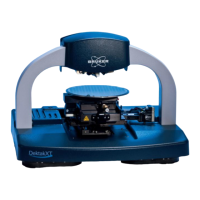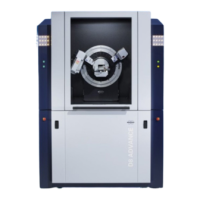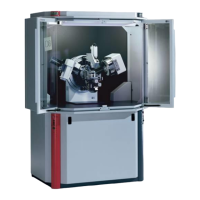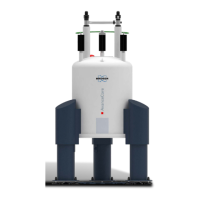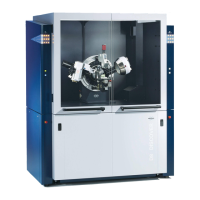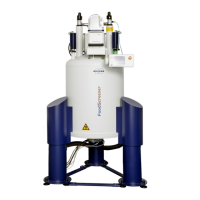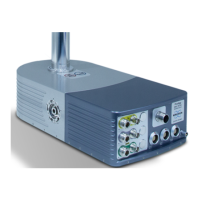User Manual D2 PHASER
DOC-M88-EXX141 V5 – 01.2015 4
Design of the diffractometer
The main component of the D2 PHASER diffractometer is the goniometer (fig. 12). Further essential
components are tube (c) with housing and mount, sample holder (d), detector with mount (e)
(LYNXEYE or scintillation counter) and primary and secondary optics components (slit systems). The
system is installed vertically in a radiation protection housing and meets all requirements for fully
protected X-ray systems, as written in the last valid german X-ray regulations (German Law
‘Röntgenverordnung’: Pattern approval as fully protected system according §8, Anlage 2 Nr. 3 RöV
and French radiation safety standard: AFNOR NFC 74-100).
When the user switches off the HV of the X-ray tube, the lock of the front door is released and can be
opened. The door and other safety relevant components are controlled by an electronic safety system
((f) in fig. 14 and (a) in fig. 16).
Danger!
Never bridge security switches and never make any changes of the security
protection system! This is strictly forbidden and dangerous!
Goniometer
The goniometer of the D2 PHASER (fig. 12) moves the X-ray source (c) and the detector (e)
simultaneously relative to the sample surface (d) with --geometry (sequence of movement is shown
in fig. 13). Tube and detector are mounted on two arms which move around the goniometer centre ((d)
in fig. 12).
The tube with its housing and primary slit system is fixed to the primary goniometer track. The detector
(LYNXEYE or scintillation detector) with slit system is mounted onto the secondary track.
The D2 PHASER diffractometer is designed for a measuring circle radius of 141,4mm. This design
guarantees best resolution with compact dimensions simultaneously.
X-ray tube
Sealed X-ray tubes ((a) in fig. 14) with line focus (12mm x 0,4mm), earthed anode and ceramic body
are used in D2 PHASER systems. They are energized with power of an X-ray generator ((g) in fig. 14
and (c) in fig. 16) which is installed in the back part of the system housing. X-ray diffraction tubes are
available with Cr, Co and Cu anode.
These X-ray tubes are available for D2 PHASER systems:
Ceramic X-ray tube KFL Cu–2K, 0,4mm x 12mm
Ceramic X-ray tube KFL Co–2K, 0,4mm x 12mm
Ceramic X-ray tube KFL Cr–2K, 0,4mm x 12mm
All tubes are working with 300W (30kV @ 10mA) with long lifetime. An emission angle of approx. 6°
reduces the projection of the focus to 1/10 of its width (40μm). This geometry guarantees high
intensity at high angular resolution. Radiation protection requires that the X-ray tube is mounted within
a housing. An electromechanically driven shutter is not used. HV can only be set when the front door
is closed and locked.
To avoid overheating of the tube, there is a thermomodule mounted (fig. 15) on the tube head. The
temperature (measured by NTC sensor) of the tube’s head is displayed in the tools of the
DIFFRAC.MEASUREMENT Suite. If the temperature increases in case of malfunction of the cooling
circuit, a warning message occurs. If the temperature increases further and exceeds an alarm limit, the
generator will be switched off at 68°C. If there is a failure in the NTC sensor or in its evaluation
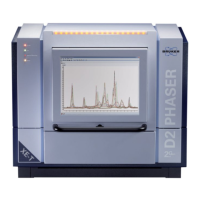
